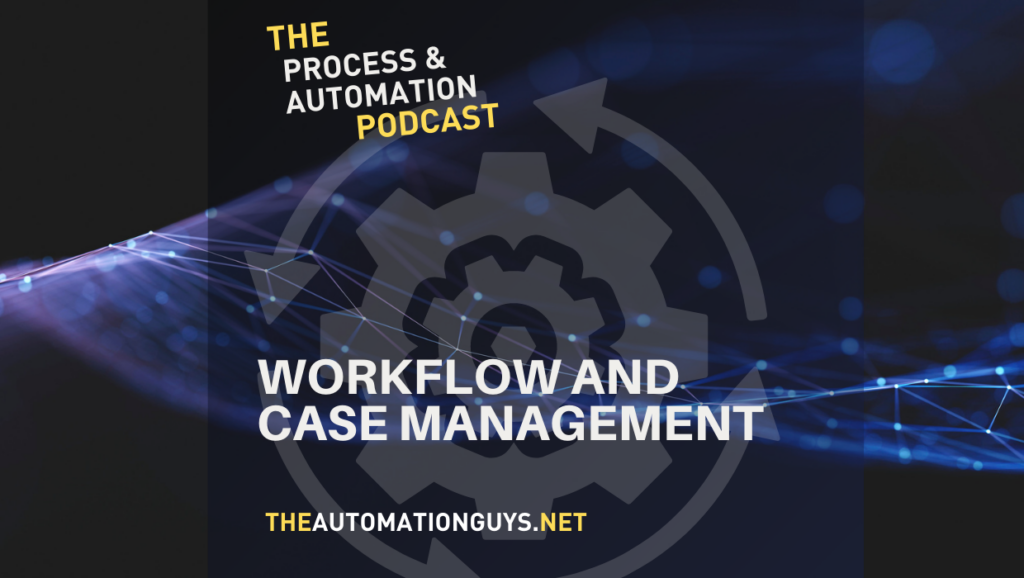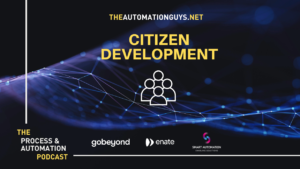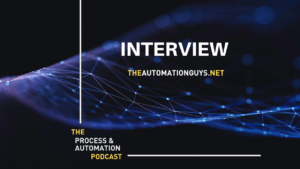Blog

Workflow Management 101
BPM, Workflow Automation, Workflow Management: What is the difference? Why should you care? If you like to find out exactly that, then this episode is right for you. Join us for Part 1 with The Automation Guys.
Share This Post
Episode Transcript
Hello, and welcome to another episode of the process and automation podcast with the automation guys. Yeah. First of all, thanks a lot to all our listeners tuning in every week to learn more about process and automation we have now, um, recorded 30 episodes already, and we are really excited to, to keep going and to record more, uh, on, on, on the content of process and automation.
Yeah. And to thank you all for your feedback and your regular suggestions for new topics. That’s very, very, um, uh, appreciated. And from that feedback we have recently, um, uh, received a question, what is workflow management and today’s episode is all about that. So let’s, let’s get that started. Arno, what is workflow management?
Yes. Very good question. I think at the heart of automation, in my opinion is still human to human workflow and the orchestration of tasks between individual. To achieve a specific outcome. And, you know, you could really look at workflow automation that, um, you know, if you look at the definition of it, it really refers to the identification, uh, the organization and the coordination of a specific set of tasks that produces an outcome.
So, you know, workflow management, in my opinion, is all about optimizing and improving. Automating workflows wherever possible to, to increase those outputs and to eliminate repetition and also to reduce errors and exceptions. And of course a workflow can include any number of steps that might involve a combination of people, systems or machines.
You can even drag RPA into workflows. And the whole idea of it is an automated sort of orchestration to achieve those, those outcomes. Um, back you want to achieve. So those people that, um, managers workflows really search for opportunities to eliminate bottlenecks and, and to improve visibility into their flows.
Um, and what, why would you say work for management is so important right now? Or was it, was it they’re always like, was this always a available workload management? Um, or is my, why is it important? I think it’s always been important, but I think as we sort of venture into this, this hyper automation world, uh, workflow management really underpins a lot of the automation initiatives that we do.
So for example, if we want to do RPA, which is robotic process automation, where we perhaps use a robot to do specific automations for. We always want to include that with inside a broadened workflow automation, which is finance process. So for instance, if you have a cash allocation in finance, you might have a RPA bot that does elements of that, the actual allocation, that the sort of the high volume transactions, but you might have a workflow process that there that actually deals with.
Um, exceptions where human actually still have to look at something that perhaps when the robot failed human needs to look at that, or it might be a human in the mix where that person needs to sign off the worker robot. So again, all of that stuff is governed by a workflow process and these processes are really important with inside our business because.
Uh, although we do use RPA a lot in, in the sort of processes and projects we deploy for our customers, um, there is still a, a very large requirement to have the human in the loop kind of still making decisions. But what we want to do is ensure that that person that makes that decision, um, has got the information at hand, you know, they don’t have to go to a third party system to download information, raise a quote or to, you know, get information to, to make their job easy.
We want the robots to do that. And all of that human interaction is still governed by traditional work processes. And that’s why it’s really, really important. Yeah. And I think, even with some technology in place, um, I think the flows are not really, really that efficient, um, in most companies, isn’t it.
So it’s just looking at really some, some subsets and not really how the whole work flows to really throw the company. And, um, that still leaves some, uh, I think in, in some, some departments are generally everyone still, um, has many manual and lots of tedious tasks. So I think it’s time to, to really improve that.
Yeah. And I guess, you know, sort of coming back to, you know, why, why we think that is important, but I think that there’s a whole range of reasons clearly. And we know that, you know, work for managing systems does increase productivity. Um, of course, when you increase productivity, you reduce employee frustration.
It improves customer satisfaction because of course it produces tedious tasks by speeding up response times, for example, you know, a key component of workflow management is the ability to automate as much as possible of a particular. And, you know, there are sort of a few ways in which you do these automation.
So for example, you would standardize your flows and this ensure that all of your tasks for a particular process gets done in the right way every time. So there’s a standard way of doing it. Um, of course also, Um, empower your employees to operate autonomously, you know, by ensuring they know exactly what’s expected.
So a task will be assigned at a specific point in the process. Uh, you would give the information to the employee and they will do that task. And, and that would be, they would know exactly what to do to, to, to achieve that outcome. Um, and of course, you know, you can, you can increase efficiency of clot across workflows, uh, while removing bottlenecks to, to improve productivity and outputs.
Um, and you can streamline communications and collaboration across your teams and your organizations with automatic notification. Uh, for example, when a task status changed, Um, you know, and again, you, you know, you can, you, you can build alignment by, um, sending, you know, automatic updates, emails, deadline notifications.
So these are all really, really good ways. Um, why workflow automation is important. And of course also workflow automation provides, uh, uh, audit trail, um, and, you know, These metrics are available to managers to, to measure performance of your workflow with the view to increase your web or to improve your work on it.
Yeah, absolutely.
So I think there’s, there are some reasons, so all these benefits, um, uh, are really, um, really obvious as well. Um, um, when you start, when should you actually start investing into workflows? This is a very, very big question for, um, for our listeners. Um, and, and of course every organization is unique, um, but there are some, some really obvious signs.
That stand out that suggests your organization would be better off with workflow solutions management solutions, um, and some, some, some of business, um, experience, for example, persistent cash flow issues, employees constantly indicating they’re overworked or burned out. Um, Customers are complaining regularly.
So that, that really shows some, something is not working so well. And there’s somewhere maybe an improvement to be, to be made. Um, uh, recurring issues was things like scheduling and payroll, all these, all these administration tasks in the, in the backend. So if they are starting to, yeah, it doesn’t really work.
Nice. And I’m in a good flow. Um, you know, you have to address those things. Um, uh, some other reasons are. Projects often unfinished your team relies heavily on spreadsheets. I think this is a big one. So this is what you mentioned a couple of times, he as well on this podcast. So you focus a lot where all these spreadsheets in the business and where all the email based workflows really in the business and were still paper and use.
So if you, if you pinpoint on a lot of that stuff, um, it’s a good point or a good sign that you can. Yeah, there’s lots of potential for, for improvement here. Um, lots of data entry and repetitive tasks are happening copying data from one screen to the, to the other, um, uh, you manage, um, yeah, lots of, uh, um, teams of workers, contractors, and other external workers and, um, the main systems in your organizations, um, um, yeah, rely on, uh, On communication was other systems, though, if you have plenty of that.
Um, and, um, yeah, I think you’ve read some of those signs. There is workflow management there as a, as a tool for you to pick up and, uh, just, just a small list of things. There could be so many inefficiencies, you mentioned earlier, standardized processes, and, um, you can, you can find out more of those signs.
And these are you, you, you mentioned it like rotten apples in, in, in your business. Um, and, um, and process, if you, for example, use as well process. Um, you find lots of those kinds of, um, uh, small issues. Um, but if you have many of those small issues, um, um, they, they then come get multiplied by and becomes really a big problem for, for your customer service, et cetera.
And, um, for your supplier, uh, communication interaction and all that. So yeah, I think they, they are these telltale signs. You know, if you look at how your employees work, um, there’s a lot of spreadsheets around. There’s a lot of, um, workflow activities that takes place within site emails, where people start emailing staff across randomly to people to deal with, um, shared inboxes.
Um, the, these are. You know, signs that that workflow is really something that that is needed with inside your business. Um, you know, uh, you, you, you know, you have a small example where let’s look at, um, raising a purchase requisition. Now that in itself is quite an easy workflow, but if you don’t have an automated process, There’s a lot of emails that flies around in a very ad hoc profession to drive those outcomes for purchase requisition.
So what we saying is that, um, if you introduce a workflow process that governs and orchestrate that process, so everybody knows at each step of that process, what they involvement is you’ve got visibility into the process. You’ve got a good audit in the process and the process is standard. You know, everybody knows what to expect.
Uh, you know, what, what is the next step in the process? Um, that’s really where the benefits and the values of, of workflow management comes into play. So, you know, for me, it’s, it’s a, it’s a really important element of automation. I think it’s still will be quite an important element, you know, in the future as well.
Um, because 80 is just that automation where. Even if you forget about all of the progressive technologies like artificial intelligence, robotic process automation, process mining, um, all the clever stuff you can do with chat bots. You know, th this is still a way to move away from manual paper-based Excel over email based processes, right?
Yeah. We shouldn’t should always look at the next, next shiny thing. I definitely have to get sort of the foundation right. First is not so sure chatbots alone will, will help with lots of stuff. But if the foundation is not even right then, yeah. W what are we talking about now? So, um, And it is it’s difficult sometimes, or I can understand lots of businesses out there who always want to look at the next, uh, next shiny thing out there.
Um, because it might, might be, there might be the. Just by bringing in that specific AI technology, it would solve all your business problems. But, um, no, I think a combination of that, um, we’ll, we’ll give you the biggest benefit, but a big one, as you said, Arnaud is, uh, is the, um, is getting, getting the first steps done.
Isn’t it? And do get that, that right. Um, and again, and again, they are some best practices. When you start with workflow and workflow management. And, uh, you know, there are several ways to ensure that you successfully adopt a new workflow management system and, you know, you need to still carefully plan and prioritize and communicate the goals of the system to, to all of the stakeholders.
Um, you need to choose your technology right. Um, you know, that technology to, to, to, to achieve the actual outcomes you desire very quickly. So that that’s, that’s very, very important that you still apply these best practices. And, uh, you know, and, and, and one of the best practices is to spend some time prioritizing and to set yourself some goals for, for your work for management system.
So, you know, before you spend any money, Um, you know, uh, creating, uh, buying a workflow management platform or investing in sort of automating, every task with inside your business, you know, you need to consider what is your top priorities and, you know, you need to gather the stakeholders.
Around the table, um, in swimming sessions to, you know, to figure out, you know, what is each team’s biggest frustration and what’s the worst bottlenecks with inside the business. And, um, and then you can choose the, the most common workflows that you think you could then take forward into your automation.
Um, so for example, if the majority of your time is spending, responding to customer service requests, you know, you might want to find a way for customers to interact with your system, you know, without worrying about sort of access control in any of the other security issues. You don’t want to make that really quite seamless for them.
Um, if for instance, you, you manage, lots of contexts, with inside your business. You probably want to find you in the workflows, um, to streamline that process. So let’s say it’s all about sort of, um, you know, prioritizing setting, self you those goals and identifying those processes, which is really important.
Or your business. Um, and of course, you know, what you want to do is also you want to document, uh, your, your, your current workflows, you know? Um, so, so obviously the bit, the goal of, of planning across your teams is to remove time-wasting repetitive processes for each of those team that will go to this various teams.
And you know, what you want to do is you want to see. Uh, operationally how they work and, and you want to identify the issues with the, um, existing workflows and, you know, you want those stakeholders to sketch out really a flow chart of the things they do most often. And you want to take notes of those.
Stressful error, prone steps. And, you know, during that exercise, you know, it will be helpful to really think about how you might want to, um, automate those, those, those processes. And, um, a good, a good way of measuring success of that automation is that if you expose somebody brand new to this process and it’s automated, And they’ve got no knowledge of it.
Can they just be part of the system? Can they just, uh, literally, um, you know, stop participating and do they work? And the workflow orchestration will actually assign them, um, their tasks that they need to do. And it’s very easy for them to do, to do that. And of course, you know, when you draw out your workflow, Uh, in a very visual way.
It’s quite easy to explain that to people as well as also then very easy to develop. So if you have a customer onboarding scenario, for example, you, you map out all your roles for your customer onboarding, you map out how the flow works. And then it’s very easy to, to actually, um, you know, configure that with inside of a workflow.
Yeah, the, these, these two points you just mentioned, uh, I see as well, that they’re very, very important, although I was saying, okay, don’t look at the next shiny thing all the time, but once you maybe have covered your basics, I think these two points can. Can be, can be done with some, some of these new, great technologies out there, like, like process mining to really find out what are your candidates for automation, um, and where you should prioritize, um, uh, et cetera.
Um, uh, process mining will potentially uncover all these, uh, these opportunities. And then you have a nice list maybe of 10, 15 different, uh, different things you want to tackle. Yeah. And just mentioning process mining, uh, related to the, to the, to the second point you just mentioned. Um, sometimes, uh, yeah, I think every stakeholder should know.
What’s going on in their processes. Um, but sometimes these processes are not. Um, so they usually come now, um, on paper, based on the, the perfect world or the view of a specific person or a memory of a specific person within was in the, um, department. But sometimes. They are not even accurate anymore. So it’s obviously that is the essays and there’s the two B maybe to stakeholders should be definitely be involved in the two B.
Um, but sometimes the, as this is very difficult to identify, um, and, uh, in a large organization, it’s also very time-consuming, uh, exercise. Um, you mentioned it a couple of times a year on the podcast as well. A very traditional, we did this with, um, uh, just a stopwatch and, and observing people. Isn’t it.
Then, then recording. Okay. It takes five minutes a year and it takes one minute there, um, uh, going through the, the, the, the process flow, but, uh, yeah. Was these new technologies. And if, if you have a bit, bit of a bigger organization, it makes sense to. Maybe we get help of these technologies and it maps out the as is process, um, as it actually happens through all, uh, throughout all your systems.
And that, that could be quite, quite useful to, to actually, um, decide what, what, what to automate. Yeah. And I think if, of course, if you do struggle and you don’t know where to start tools like process mining more kind of be a Pathfinder for you. Um, and, you know, I, I think, you know, let, let’s not, let’s not forget about the strengths of those progressive technologists that we always talk about.
Um, but I think for workflow management in general, um, if you look at the standard workflows within site, um, you know, finance, operations facilities and, and, and other teams, there are standard ones, which you probably don’t need a process mining to. To create your first automation. And I think that that’s kind of like the point for, for workflow management is to really try and identify those, um, you know, the, the, the, those processes, which, which kind of creates, um, I guess that, or, or is, is really very inefficient and creates the Mon the most sort of friction with inside your business.
Um, and then from there on, you know, you can always evolve. Uh, and use things like process mining to, to actually uncover more things. I guess the point is you, you need to start somewhere and within sight, every business, I don’t think you have to look too far to actually, um, find these, these, these opportunities.
Um, you know, and I think if you, if you do talk to. Two teams within sight, a business. Um, you know, it wouldn’t take long for you to actually uncover some of these requirements. Um, you know, and again, like I say, whether or not you talk within finance, uh, operations, uh, HR legal, um, you know, there, there, there, there there’s a lot of these opportunities that exist that you can start engaging your stakeholders.
I ask them how they conduct their work or maybe do the time and motion study, how they do it and stop mapping. Um, you know, some of these processes and automate them.
Unfortunately, that’s it again with this episode of the process and automation podcast. If you liked this episode, please give us a five-star rating and don’t forget to subscribe to this podcast so you don’t miss any upcoming episode. We hope you will tune in next time. And until then let’s automate.
- June 8, 2021
- 8:05 pm


